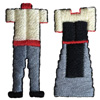 In the 18th century, all of the European and American ladies wore petticoats under their skirts. Petticoats were rather voluminous, usually quilted. They gave the needed fashionable silhouette (hiding the outlines of women’s legs) and provided warmth, as the climate was somewhat colder at the time. In the early 1700s, women started to wear dresses open in the front, so they used fine petticoats, often adorned with embroidery or intricate quilting motifs, that peeked from under the skirt. Here are several beautiful examples of 18th-century petticoats.
In the 18th century, all of the European and American ladies wore petticoats under their skirts. Petticoats were rather voluminous, usually quilted. They gave the needed fashionable silhouette (hiding the outlines of women’s legs) and provided warmth, as the climate was somewhat colder at the time. In the early 1700s, women started to wear dresses open in the front, so they used fine petticoats, often adorned with embroidery or intricate quilting motifs, that peeked from under the skirt. Here are several beautiful examples of 18th-century petticoats.
All of the photos are from The Met Museum
Swedish quilted petticoat with exquisite embroidery, 1740-1760. At the beginning of the 18th century, women started to wear dresses open in the front, so they used fine petticoats underneath that peeked from under the skirt. Usually, they were quilted petticoats and often adorned with needlework or another decoration in the front


British silk petticoat in lovely mustard & white colors, the mid-18th century. The quilting motif is so elaborate


Cute American or European petticoat in silver metallic color, the mid-18th century. This shiny fabric looks rather modern, kind of futuristic even


French petticoat with pretty quilting, the 18th century


American petticoat, the 4th quarter of the 18th century. It looks rather simple and not as full as some other petticoats from the 1700s

American wedding petticoat from the 4th quarter of the 18th century. The quilting motif is so wonderful – with the Tree of Life, flowers, birds, and deers


American or European petticoat embellished with striking quilting, 1750-1799

French quilted petticoat from 1795. It was produced by an extremely skilled artisan because the quilting on this garment is a work of art – the 3D look impresses




